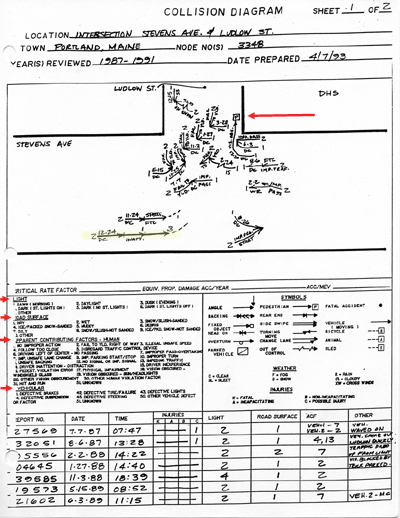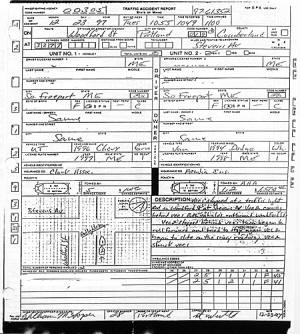SAP
Speeding and Accidents -
Vehicle
Accidents
Stevens Avenue Project :
Speeding and Accidents 1998
VEHICLE ACCIDENTS
1993 Stevens Avenue Pedestrian Study Phase I --Data Collection andProblem Identification Report is here.
1998 PACTS Phase I Report Final Monitoring Report is here.
Phase I Final Technical Supplement Appendix III Accident data is here.
click for larger image
| Explanation: As seen
before, This is an collision
diagram used by the Phase I Report writers to portray some of
the accidents that occurred at Ludlow and Stevens. The long red arrow is pointing to the pedestrian accident, explained on the previous page. . The short red arrows to the bottom left refer to the "conditions" block in the lower right. To explain the data: Looking at the first accident diagram on the bottom of the upper block (underlined in yellow) , we can see Dec. 24, 1990, there was a 3-car accident where #3 was making a left turn, whereupon it was struck by car # 1, which was hit by car # 2. Driver inattention was the cause. It was daytime, and the road was dry. Details are denoted in the second page of the list. There were 5 vehicle accidents officially presented as evidence of a speeding problem on Stevens. |
 |
The BIG problem is that once again, speeding is not the problem! (names redacted)
| 97-61352 | 97-61376 | 98-914 | 98-10341 | |
 |
_small.jpg) |
_small.jpg) |
_small.jpg) |
_small.jpg) |
97-61352: Dec. 23, 1997: 1055am, snowy road. Vehicle # 2 rear-ended Vehicle one after a stop,
then rolling forward, unable to stop on the slick surface.
97-6136 : Dec. 23, 1997 : 1138am, Vehicle 1 stopped for a red light, Vehicle #2 was unable to stop
while slowing on the slick surface.
98-914 : Jan. 7, 1998: 915am , Vehicle # 1 was parked in front of Quality Shop unattended when
Vehicle #2 backed into it.
98-10341: Feb. 10, 1998 reported at 1030am: Vehicle # 1 was stopped at the Woodfords / Stevens
Ave light, and backed up a block, colliding with a car crossing Stevens from Higgins St.
to Ludlow.
No # : March 23, 1998, 626pm: Car #2 stopped close to the Woodfords / Stevens intersection,
in front of a driveway, and noticed that somebody was backing out. #2 backed into #1,
causing "minor damage"
NOTE: There is no speeding mentioned anywhere in these "representative" examples.
That's probably because there WAS no speeding problem on Stevens. It was manufactured to get money from the federal and state government, and that's illegal.
Because of the confluence of the signal light at Stevens and Pleasant, and the crossing guard in front of the school, when school children are in front of the schools traffic may be able to get up to 15 MPH if it’s lucky. 5-10 MPH, just where it should be, is more likely.
The crossing guard didn't have 4 complaints lodged against him in 1997 by the drivers of the busses he was slowing down, for nothing. They were running late.
DPW head William Bray stated to the Portland Press Herald that accidents had decreased after the speed tables were installed.
He stopped saying that after I told him that according to Maine DOT there were 35 accidents prior to the hump installation and 59 afterwards, which didn't seem like a "decrease" somehow. It's a 58% increase according to the FHWA.
I spent a few hours at the Portland Police Department in early February 2001 looking at all the accidents that had occurred on Stevens from 1996 to that date. Accidents had increased 40% since the humps were put in--and that is with 2,500 fewer cars on the road.
I found 5 that occurred as a direct result of people slowing for speed humps - they were rear-ended by people not paying attention to their driving. The car in front would slow for the humps, and the following car would ram the first one..
Driver inattention, failure to yield, and obstructed vision were still the leading causes of accidents on the street.
Speeding (improper speed) was the cause of 2 accidents- interestingly, the same number that hump proponents thought was so bad back in 1997 - and that was with 2,500 more cars on the street (16,000 vs 14,500 today)! So, things have gotten worse!
So, what is causing the 58% increase in accidents?
It could be that the slower speeds create a situation where the driver is now paying less attention to the road just because he is going more slowly - less speed, less "risk", more inattention - which leads to people rear-ending the cars in front of them. Thus, project proponents have created the exact opposite of the results they were looking for.
The Brighton Avenue
calming project saw about a 45% drop in accidents after the
roadway was narrowed from 4 lanes to three. This occurred because the
road was more dangerous than it was before. All the traffic was
now lined up, still doing 35-40 MPH in one lane, and that gets peoples attention.
The Brighton Project was done against the professional engineering
advice of the designer , Thomas Gorrill; the City Traffic Engineer,
Lawrence Ash; and DPW head William Bray.
As I've said elsewhere, why bother to pay these people when you just
ignore them?
Back to Pedestrian Accidents
Top